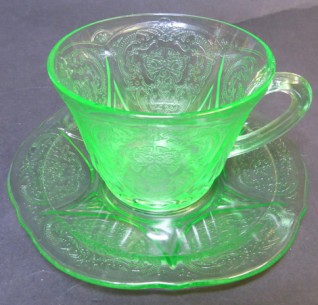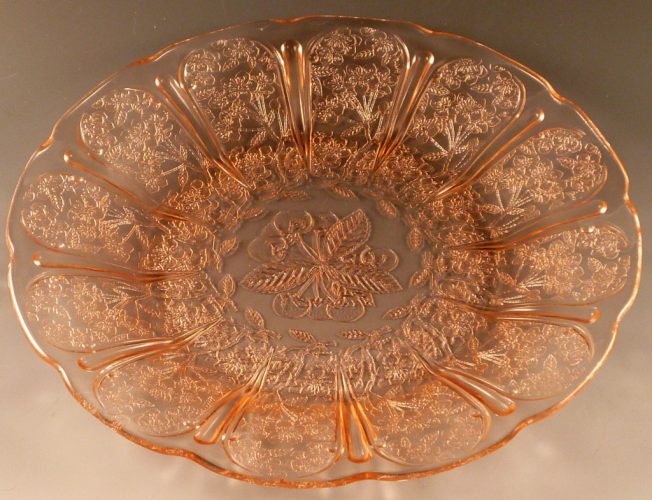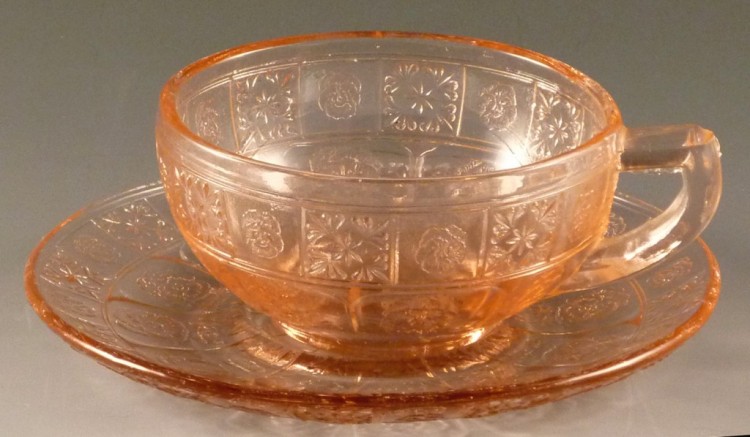 The phrase ‘Depression Glass’ is often treated as an umbrella term, a catch-all definition used by collectors somewhat indiscriminately to describe a type of inexpensive glass (either clear or coloured) that was manufactured in large quantities; primarily during the 1920s and early 1930s (though various forms were made over the decades that followed as well).
The phrase ‘Depression Glass’ is often treated as an umbrella term, a catch-all definition used by collectors somewhat indiscriminately to describe a type of inexpensive glass (either clear or coloured) that was manufactured in large quantities; primarily during the 1920s and early 1930s (though various forms were made over the decades that followed as well).
Sadly, due to the somewhat ambiguous nature of depression glassware, it is easy to fake, and today, a great quantity of what is sold on eBay and other online auction sites is actually a modern reproduction of the original, authentic article. Faux depression glass is currently being manufactured in Asia and imported throughout the world; when shopping for this type of glass, always be wary of terms like “Depression era-style” or “Depression style” glass, as such phrases usually indicate that you are looking at new or recent items which have simply been designed in the style of 1920s-30s era glass.
Understanding Depression Glass: Types, Terms, and Manufacturers
Delineating the broad spectrum represented by this form of glass begins with understanding its types, forms, the terms used to identify them, and the manufacturers responsible for the original sets of tableware now so sought after by collectors:
- About twenty different glass companies were responsible for the bulk of depression-era glass, almost all of which was produced in the midwestern or eastern United States. Out of these twenty different Depression glassware manufacturers, the most influential are generally thought to be Hazel Atlas Glass Company, Hocking Glass Company (which was also known as Anchor Hocking Glass Company/Corporation in later years), the Federal Glass Company, Indiana Glass Company, MacBeth-Evans Glass Company, Jeanette Glass Company, Imperial Glass Company, L. E. Smith Glass Company, Lancaster Glass Company, and the U.S. Glass Company.
- Depression-era glassware is known for coming in an amazing rainbow of colours, the most common and popular of which were green (in light to medium shades, and various hues), pink and peach tones, and amber (primarily a light yellow-amber), and of course plain clear glass, all in etched or geometric patterns.

Some colours are particularly sought after as they were made in lesser quantities, and are thus very rare today. These special shades include amethyst, pure canary yellow (rather than the greenish-yellow shade which was fairly common), cobalt blue, opaque black (this is seldom a “complete” black, however—it often shines purple if you hold it up to a particularly intense light), jadeite (an opaque or translucent green), white “milk” glass, and crimson.
- There is a great deal of overlap between the categories of depression glass and uranium glass; the vast majority of green-coloured Depression-era glass contains at least a bit of uranium, which produces a pleasant fluorescent glow under ultraviolet light (including daylight). The uranium used in this glass is, it should be noted, a fairly stable and safe form of uranium, so one ought not worry about this aspect of the glass when collecting it.
- The above fact sometimes causes depression glassware to be labeled as “vaseline glass”, but this is not actually correct. While true vaseline glass does also contain uranium, it’s nevertheless an entirely separate category, one which denotes an older style of glass dating all the way back to the Victorian era. Vaseline glass trends more toward the yellow side of the spectrum, and reached its greatest height of popularity in the 1880s, long before depression glassware was in circulation.
- Due to the fact that depression-era glassware was often given away as part of the promotional campaigns for various goods (remember, this was a time when money was scarce, so retailers were very eager to entice customers), it is sometimes confused with carnival glass, but this is also a fallacy. Carnival glass is a separate category, and like vaseline glass, it is one which came into existence earlier (in the early 1900s) and refers to glass that has been “carnivalised”, which is to say glass that has had an iridescent, multi-coloured, gasoline-esque sheen added to it (this was done via the use of metallic salts during production).
- Depression glassware is sometimes broken down into a few categories; the term elegant, for example, when applied to this kind of glass, refers specifically to American hand-pressed glass which may have been made anywhere between the years 1925-1955 (this type was more expensive, more transparent, and had a better finish). The word Crystal may be added to describe forms of depression-era glass which were clear and patterned. Depression glass is often also used to refer to the cheap machine-made glass of the 1940s through 1970s, even though the actual depression had long since ended by the 1970s; ergo, if you are looking for glassware from the actual depression era, it’s important to verify that is what you’ll be getting prior to making a purchase.

